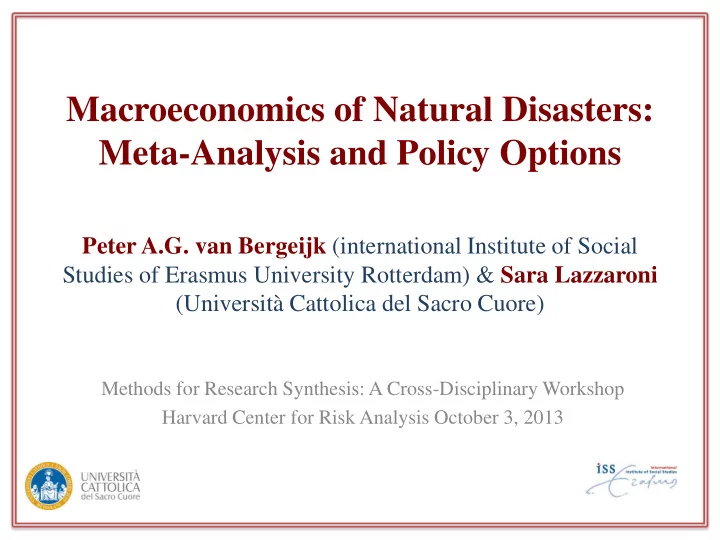

Macroeconomics of Natural Disasters: Meta-Analysis and Policy Options Peter A.G. van Bergeijk (international Institute of Social Studies of Erasmus University Rotterdam) & Sara Lazzaroni (Università Cattolica del Sacro Cuore) Methods for Research Synthesis: A Cross-Disciplinary Workshop Harvard Center for Risk Analysis October 3, 2013
The paper in a nutshell • Emerging field : macro economic impact of natural disasters • Meta analysis of 20 macro-econometric studies (including ‘grey’ literature): – with and without control group – different sets of resilience factors – with and without disaster variable – Substantial heterogeneity in results • Meta-regression analysis to assess the influence of empirical design (data and econometric specifications) and methodology • Comparison with the leading research synthesis (IPCC narrative) • Major finding 1: heterogeneity of results is due to modelling strategies and data set; importantly it distorts evaluation of mitigating instruments. • Major finding 2: narrative could have been more confident on negative impact and more transparent on inclusion and qualification of studies if complemented by a meta-analysis • Most important research needs : – Format for primary studies & best practice rules for search strategies & study selection. – Inclusion of population and institutions in primary studies. – Use of alternative data sets. 30 IX 2013 Macroeconomic costs of natural disasters 2
Macroeconomics of natural disasters Increasing costs of man-made, Median t-value of the primary weather & earth related disasters studies 2002-2013 5 0 -5 t-value -10 -15 -20 2002 2003 2004 2005 2006 2007 2008 2009 2010 2011 2012 2013 Year of publication 30 IX 2013 Macroeconomic costs of natural disasters 3
30 IX 2013 447 t statistics statistics of 20 studies in the meta analysis t-value -20 -15 -10 10 -5 0 5 Kellenberg & Mobarak (2008) Raschky (2008) Noy (2009) Strobl (2011) Rasmussen (2004) Tavares (2004) Macroeconomic costs of natural disasters Bergholt (2010) Kahn (2005) Haeger et al. (2008) Noy and Nualsri (2007) Escaleras et al. (2007) Loayza et al. (2012) Toya and Skidmore (2013)° Jaramillo (2009) Padli et al. (2010) Vu and Hammes (2010) Anbarci et al. (2005) Mean Skidmore and Toya (2002) Kim (2010) Median Padli and Habibullah (2009) Stromberg (2007) Toya and Skidmore (2007) 4
IPCC Special Report for Managing the Risks of Extreme Events and Disasters to Advance Climate Change Adaption • Highly political/controversial issue – since Albala-Bertrand (1993) (long run impact is small) – disaster vulnerability and development (non graduating LDCs) • IPCC’s (2012) major & highly influential research synthesis is narrative . – Aims to ‘assess science in a way that is relevant to policy but not policy prescriptive’ – Assigns ‘ medium confidence ’ to the prevalence of a negative impact of disasters in the short run – ‘ Disagreement is due to analytical weaknesses ’ (lack of counterfactual, failure to account for informal sector, insurance, aid and disaster type) 30 IX 2013 Macroeconomic costs of natural disasters 5
Motivation for meta-analysis: Our reading of the reasons for heterogenity • Methodological differences – Research design decisions in emerging research field – Literature looks homogeneous (cross referencing & less hetrogeneous than micro and case studies), but actually two literatures • Preliminary state of findings (for example replication of Toya and Skidmore (2007) by Reed and Mercer (2013) • Intrinsic motivation and bias of the researchers (cf Doucouliagos and Paldam 2009 on development aid) 30 IX 2013 Macroeconomic costs of natural disasters 6
Two approaches: theory 1: Direct costs 2: Indirect costs IPCC narrative: ‘categories are rarely fully exclusive, and items or activities can have elements in all categories’ 30 IX 2013 Macroeconomic costs of natural disasters 7
Two approaches: consequences for impact mitigating factors Model 1 direct costs 100% 80% 60% 40% 20% 0% GDP Education Investment Openness Population Institutions Model 2 indirect costs 100% 80% 60% 40% 20% 0% GDP Education Investment Openness Population Institutions Negative Positive 30 IX 2013 Macroeconomic costs of natural disasters 8
Number of coefficients for different resilience variables 9
Key findings from the meta (regression) analysis • We can be confident about the negative impact of natural disasters based on the evidence in the 20 macro-econometric studies • Indirect costs studies are less likely to find a negative impact of natural disasters (+ direct cost studies are more likely…) • The use of EM-DAT (Center for Research on the Epidemiology of Disasters) decreases the likelihood of finding a negative disaster impact (+ alternative data sets increase…) • Contradictions in terms of impact of mitigating factors related to research design • Relatively little evidence is available for mitigating role of institutions and population • Primary studies do not always report key statistics necessary for meta-analysis 30 IX 2013 Macroeconomic costs of natural disasters 10
Studies (76) on disaster impacts in the IPCC Report by type of analysis Mathematical 4% Macro econometric 30% Other* 57% Micro econometric 1% Input-Output CGE 4% 4% 30 IX 2013 Macroeconomic costs of natural disasters 11
Impact of natural disasters on economic development Positive impact Meta analysis IPCC 2 3 NM Skidmore & Toya (2002) 14 NM 3 5 Okuyama & Sahin (2009) Negative impact NM: Non-macroeconometric studies 30 IX 2013 Macroeconomic costs of natural disasters 12
Strengths and weaknesses of narrative and meta analysis 30 IX 2013 Macroeconomic costs of natural disasters 13
Thank you bergeijk@iss.nl www.petervanbergeijk.org sara.lazzaroni@unicatt.it 30 IX 2013 14 Macroeconomic costs of natural disasters
Recommend
More recommend